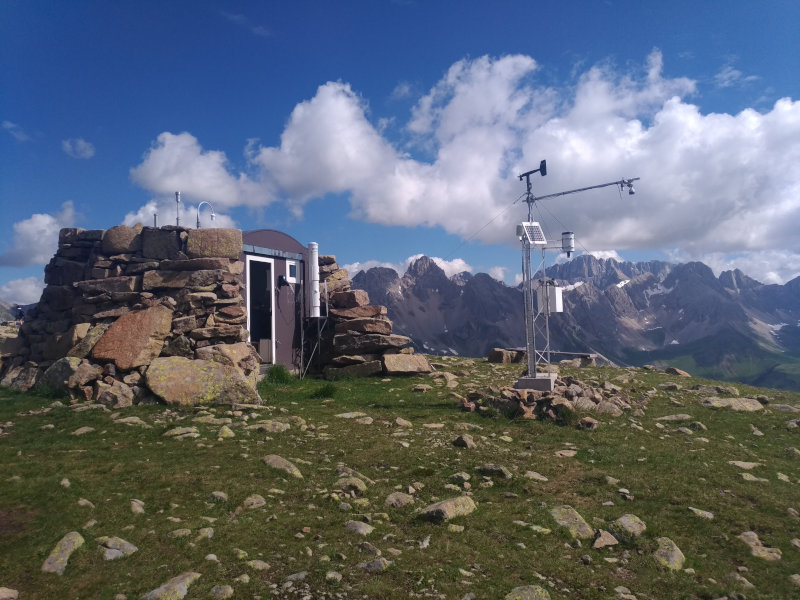Mission
The Centre for Trace Analysis is a joint infrastructure of Ca’ Foscari University of Venice and the Institute for Polar Sciences of the Italian National Research Council (ISP-CNR). CeTra is a center of international excellence for research, advanced training and services operating with universities, research institutions and companies interested in trace/ultra-trace analysis and chemical imaging in the fields of life science, environment, advanced materials and cultural heritage.
The facility makes available state-of-the art instrumentation and technical expertise for advanced studies of chemical identification and quantitative determination at extremely low levels and/or in complex matrices, and spatial distribution or structural analyses at the micro-to-nano scale.
Instrumental resources
- Clean Laboratories
- Inductively coupled plasma - sector field mass spectrometer (ICP-SFMS)
- Inductively coupled plasma - quadrupole mass spectrometer (ICP-QMS)
- Inductively coupled plasma - optical emission spectrometer (ICP-OES)
- Mercury analyzers
- Fourier-transform infrared spectroscopy (FT-IR) microscope
- High performance ion chromatograph - mass spectrometer (HPIC-MS)
- High performance liquid chromatograph - tandem mass spectrometer (HPLC-MS/MS)
- Ultra performance liquid chromatograph - high resolution mass spectrometer (UPLC-HRMS)
- Gas chromatograph - tandem mass spectrometer (GC-MS/MS)
- Gas chromatograph – mass spectrometers (GC-MS)
- Transmission electron microscope with scanning mode (S/TEM)
- Scanning electron microscope (SEM)
- Atomic force microscope (AFM)
- X-ray diffraction spectrometer (XRD)
- Col Margherita Atmospheric Observatory
Clean Laboratories
The facility includes two Clean Laboratories dedicated to the ultra-clean manipulation/preparation of samples for inorganic and organic analysis, respectively.
The inorganic clean laboratory is entirely made of plastic-coated materials designed for the low release of airborne particles, while the organic clean laboratory is entirely made of steel materials and components designed to minimize the release of organic substances and maximize the effectiveness of decontamination procedures.
The inorganic clean laboratory consists of 4 rooms ISO 6 equipped with laminar flow benches (one is additionally equipped with an extractor hood and glove box for the preparation of atmospheric aerosols filters), 1 room ISO 5 equipped with laminar flow bench and 1 room ISO 4.
The organic clean laboratory consists of 1 room ISO 7 for intermediate sample preparation, 2 rooms ISO 6 equipped with laminar flow benches, 1 room ISO 5 equipped with laminar flow bench and 1 room ISO 4.
All the clean rooms are at overpressure increasing as function of their class, equipped with ceiling installed HEPA filters for continuous filtering of the internal air and dedicated internal production systems of Milli-Q water (Elga LabWater).
Applications: contamination-free manipulation and processing of samples for trace and ultra-trace level analysis of inorganic or organic species.
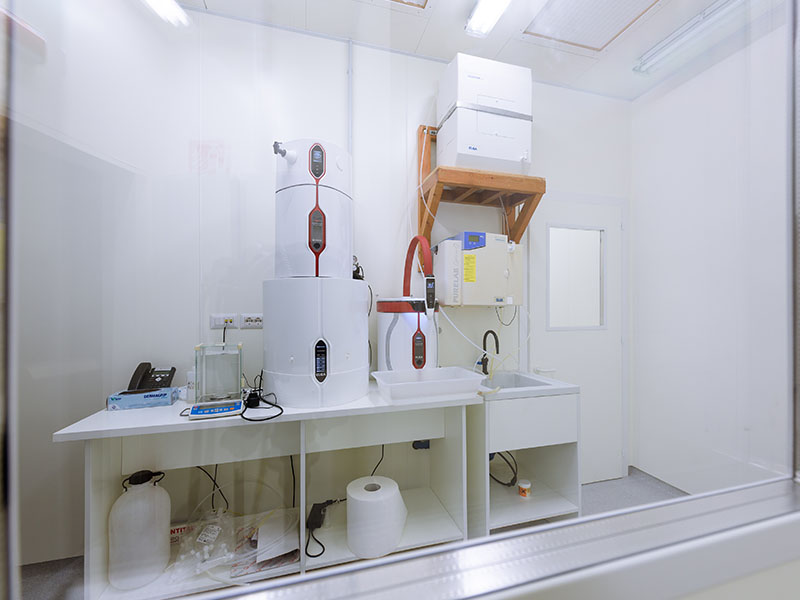
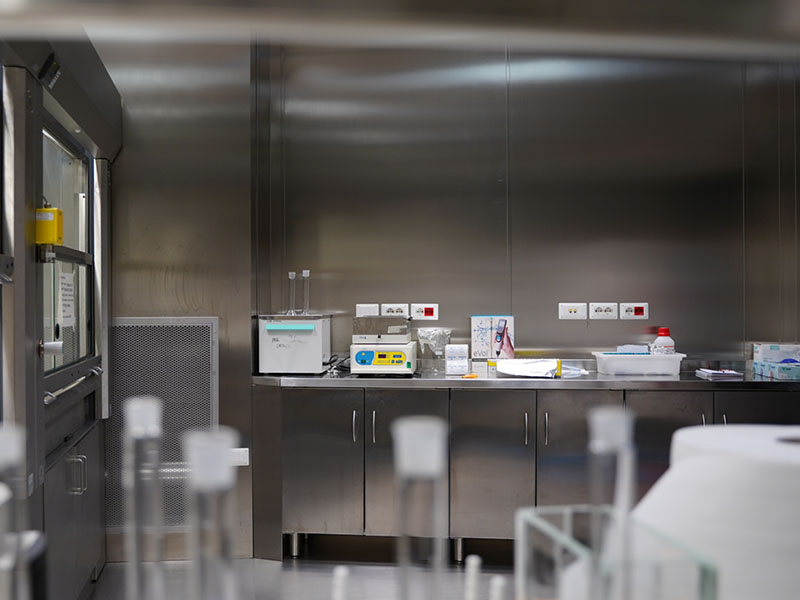
Inductively coupled plasma - sector field mass spectrometer (ICP-SFMS)
The high-resolution mass spectrometer Element XR (Thermo Scientific) allows performing interference-free high-precision quantitative determination of elements and isotopic/elemental ratios in liquid samples down to the ultra-trace level.
Thanks to a combination of high-resolution mass filter and counting, analog and Faraday detection modes, the linear dynamic range of the detector extends from sub fg/g (ppq) to over 12 orders of magnitude in solution mode.
The instrument is equipped with a SC-4 autosampler (ESI) for continuous data acquisition and can be equipped with ARIS (ESI) or ARIDUS (Cetac) desolvating nebulizer systems for further reduction of solvent-based interferences such as oxides and hydrides.
Applications: quantitative multi-elemental and isotopic analysis at trace and ultra-trace levels in environmental samples, geological analysis, material sciences, conservation sciences, forensics, clinical samples, food and biological materials.
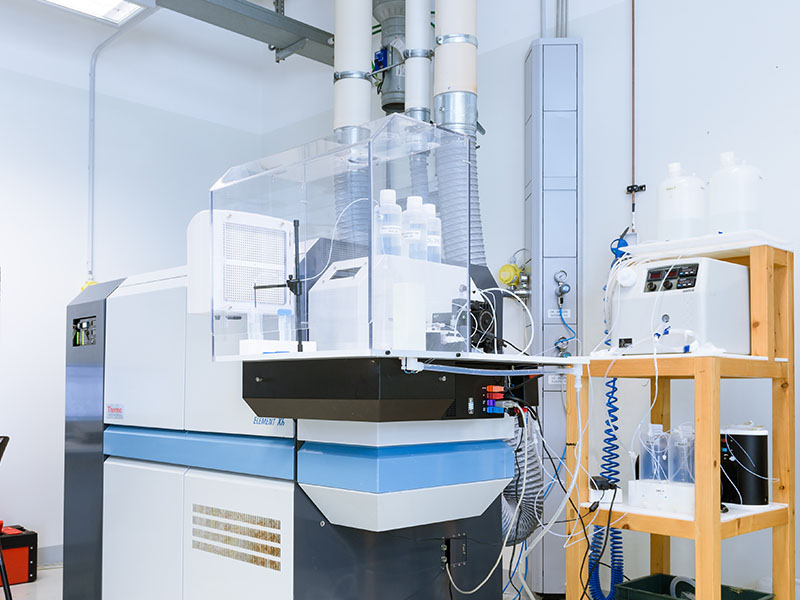
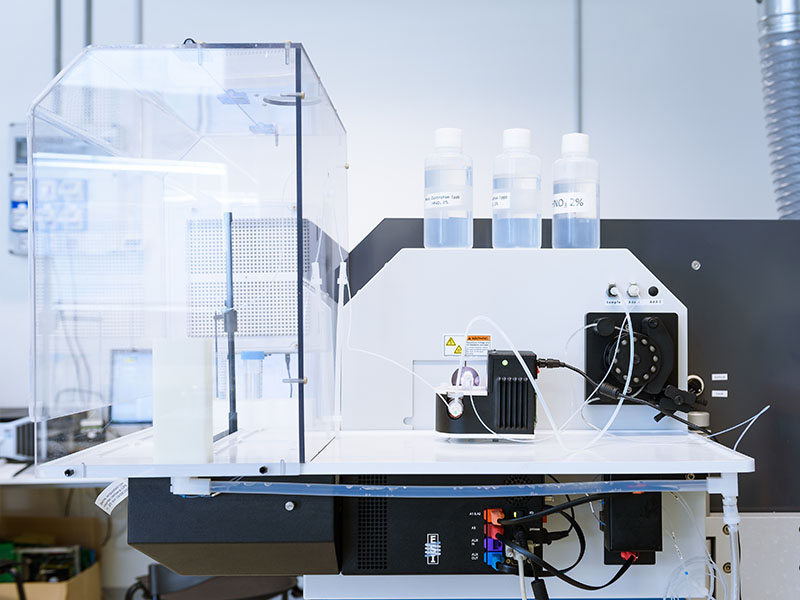
Inductively coupled plasma - quadrupole mass spectrometer (ICP-QMS)
The instrument iCAP-RQ (Thermo Scientific) is dedicated to the quantitative determination of trace elements and elemental ratios in liquid samples. The system is equipped with a Qcell technology assembly which can be run using He as collision gas and/or H2 as reaction gas to achieve reduction of spectral interferences. Additional accessories include an autosampler ASX-560 (Cetac) for high-throughput analysis, sample introduction kit for the analysis of HF mineralized samples and cone inserts for high sensitivity/robust/high matrix analysis. The instrument allows performing highly reproducible quantitative multi-elemental determinations over 9 order of magnitude in concentration in a variety of sample matrices across the entire mass range.
Applications: quantitative multi-elemental analysis from major to low-trace levels in environmental samples, geological analysis, material sciences, conservation sciences, forensics, clinical samples, food and biological materials.
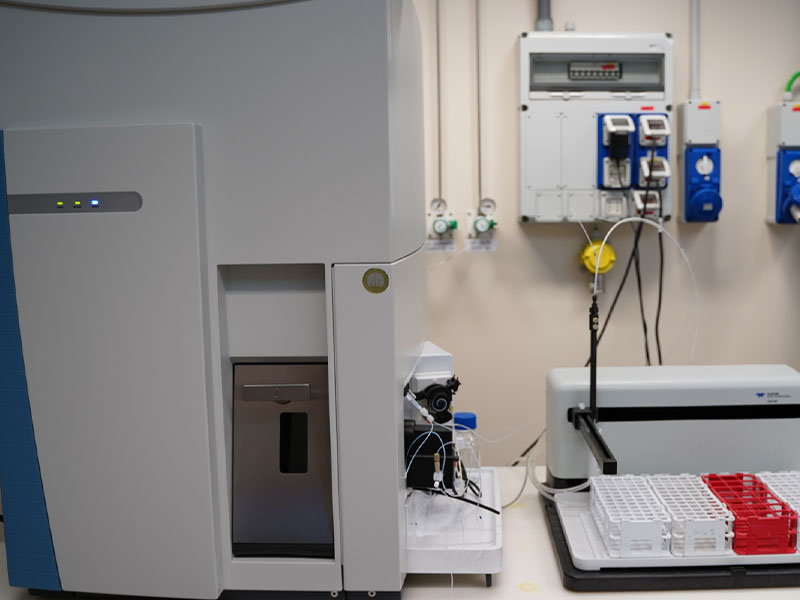
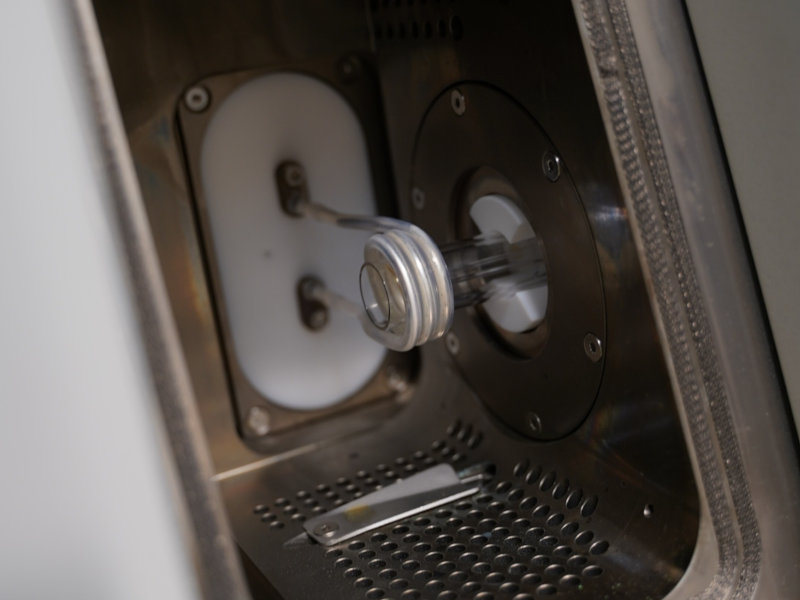
Inductively coupled plasma - optical emission spectrometer (ICP-OES)
The instrument iCAP 7400 (Thermo Scientific) is dedicated to the quantitative determination of major-to-trace elements and elemental ratios in liquid or (appropriately) dissolved samples. The system is equipped with high-efficiency light transmission system, radial or duo (radial + axial) plasma view configurations to suit a wide variety of sample types and elements of interest and a simultaneous wavelength acquisition system. Elemental concentrations can be determined with detection limits in the ppb or sub-ppb level with high instrumental precision and long-term signal stability even in complex matrices or at consistently high levels with minimized memory effects. Additional accessories include an autosampler ASX-560 (Cetac) for high-throughput analysis.
Applications: quantitative multi-elemental analysis from major to trace levels in environmental samples, geological analysis, material sciences, conservation sciences, forensics, clinical samples, food and biological materials.
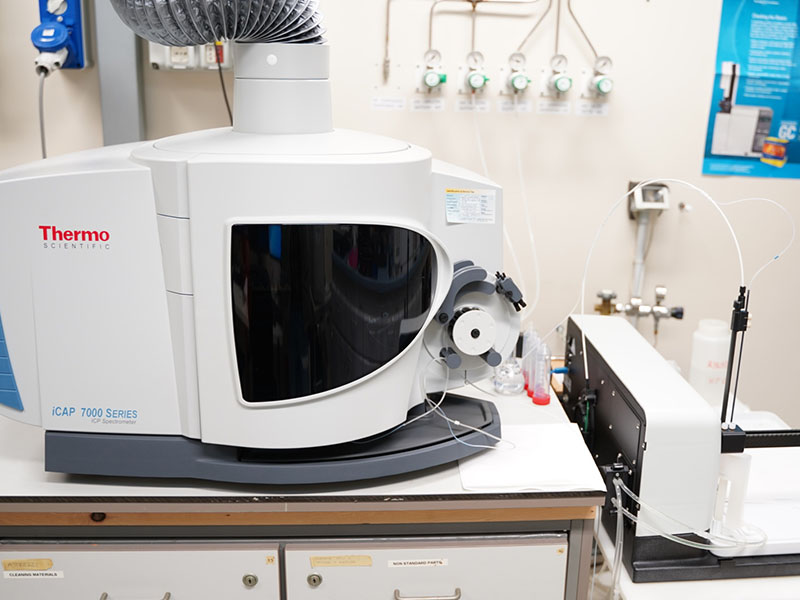
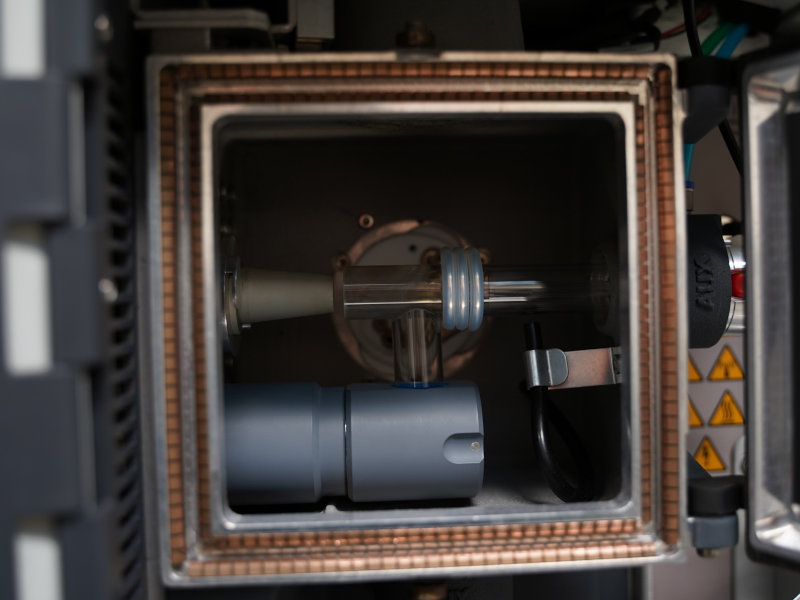
Mercury analyzer
The Mercur DUO plus (Analytik Jena) is an atomic absorption (AAS) and atomic fluorescence (AFS) spectrometer specifically designed and dedicated to the analysis of mercury in compliance with the standards EPA, EN and ISO. An integrated module with two gold collectors allows simple or cascade enrichment of mercury (according to EPA method 1631) to achieve determination limits from the low ppt to the ppq range with high method robustness, depending on the type of sample and configuration. Additional accessories include an autosampler AS-FD for high-throughput analysis.
Applications: determination of mercury in drinking and natural waters, wastewater, soil and sediments, rocks, ashes, biological fluids, food, beverages, quality control of materials.
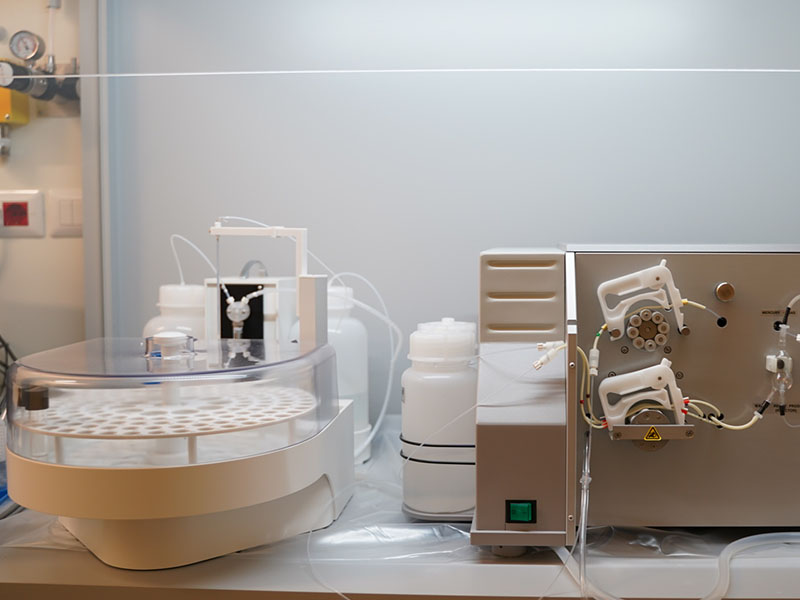
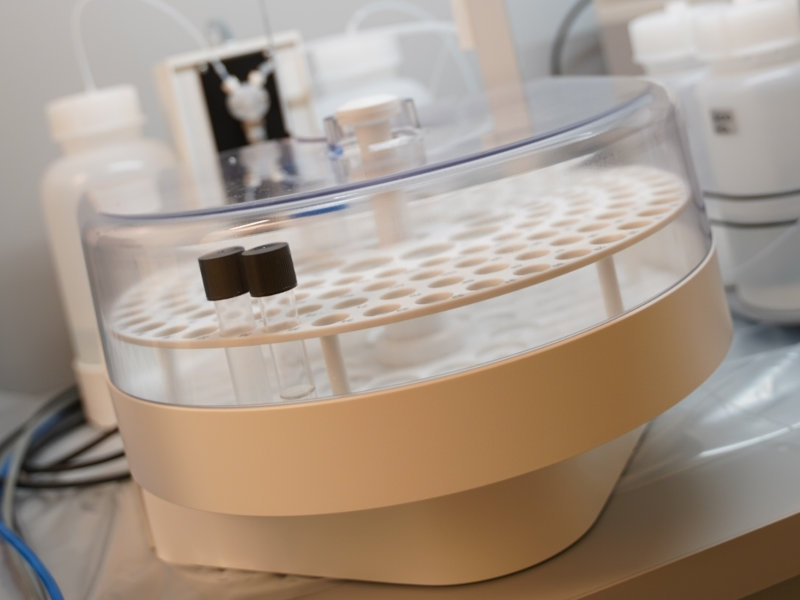
Fourier-transform infrared spectroscopy (FT-IR) microscope
The instrument is an infrared microscope Nicolet iN10 (Thermo Scientific) integrating a high-resolution CCD optical camera and a FT-IR spectrometer and is designed to perform microanalysis with lateral resolution down to a 50-microns at room temperature or a few microns with liquid nitrogen cooling. The instrument is equipped with motorized stage, MicroTip ATR device for direct contact sampling and analysis of fine structures (down to 3 microns), motorized visible polarizer for visual inspection, MTC-A detector with spectral range 7800–650 cm-1 and the dedicated software package OMNIC Picta for spectral identification of pure compounds and mixtures. Acquisition can be performed in transmission, reflection, or ATR modes. Particles analysis can also be performed to extract species-specific distributions of morphological parameters (size, shape).
Applications: microspectroscopy, material identification, packaging and laminate, coating, active pharmaceutical ingredient (API) mixture distribution mapping, identification of contaminants, microplastics identification and characterization.
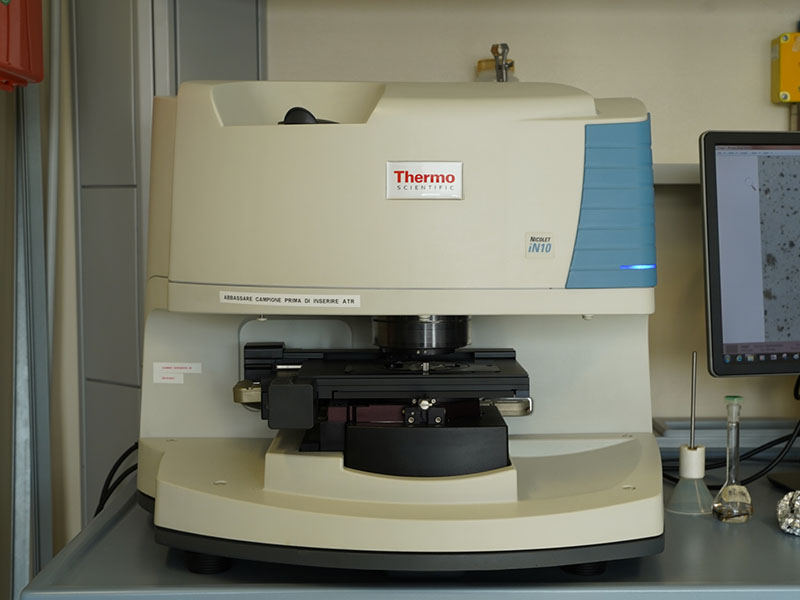
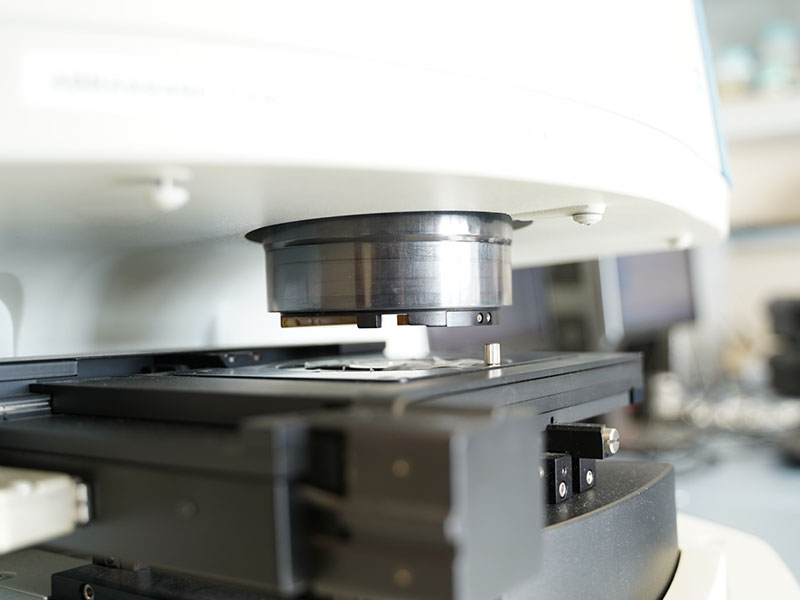
High performance ion chromatograph - mass spectrometer (HPIC-MS)
The instrumentation consists of a high performance ion chromatograph ICS-5000 Standard Bore and Microbore System (Dionex, Thermo Scientific) coupled to a single quadrupole mass spectrometer MSQ Plus (Thermo Scientific) and is dedicated to the quantitative determination of and water-soluble and ionic organic/inorganic compounds in liquid media. The chromatograph can operate up to 5000 psi to achieve high performance separation and is equipped with an eluent generator ICS 5000EG (Dionex, Thermo Scientific) configured with carbonate or hydroxide eluents for anions and metanesulfonic acid (MSA) for cations determination, suppressors ASRS 500 or CCES 300 (Thermo Scientific) to remove the salts form mobile phase before entering the MS source, and CD conductivity detector. The mass spectrometer is equipped with an electrospray source (ESI).
Applications: determination of inorganic ions and water-soluble and ionic organic compounds (e.g. sugars, organic acids) in water, sediment, soil, atmospheric aerosol, food and beverages, composite materials.
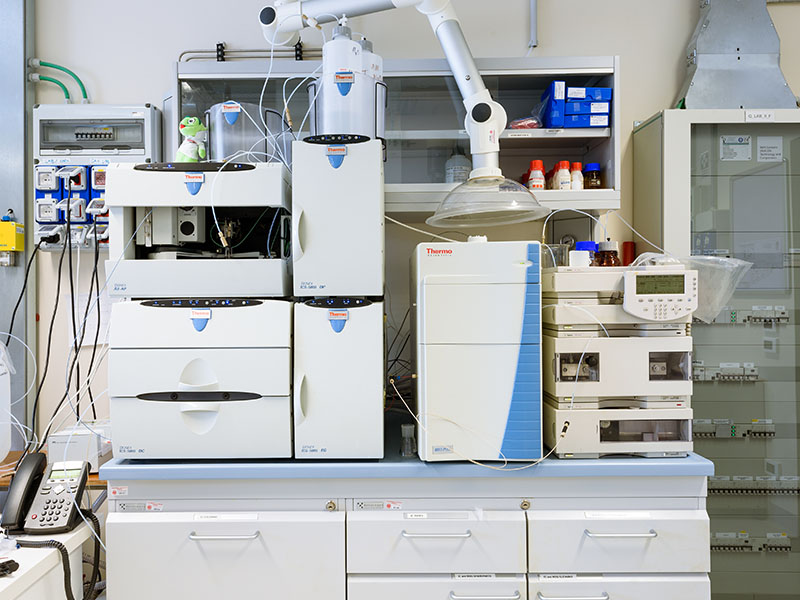
High performance liquid chromatograph - tandem mass spectrometer (HPLC-MS/MS)
The instrumentation consists of a 1100 series HPLC system (Agilent Technologies) coupled to an API 4000 triple quadrupole mass spectrometer (Applied Biosystems/MDS SCIEX) and is dedicated to the identification and quantitative determination of low abundance organic compounds in liquid media. The HPLC is equipped with a vacuum degasser, a binary HPLC pump system, an autosampler and a thermostatted column compartment. The mass spectrometer is equipped with a Turbo V source for flexible exchange between atmospheric pressure chemical ionization (APCI) source and Turbolon spray probe, capable of achieving maximized ionization efficiency and minimized chemical noise and instrumental drift.
Applications: identification and quantitative determination of low abundance organic compounds in clinical samples (e.g. pesticides/drug residues), forensic toxicology, environmental matrices, food and beverages, composite materials.
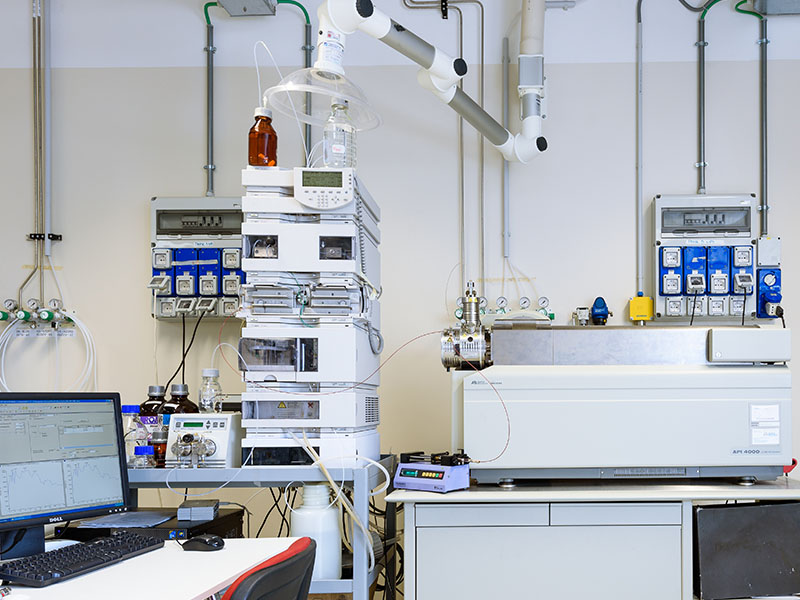
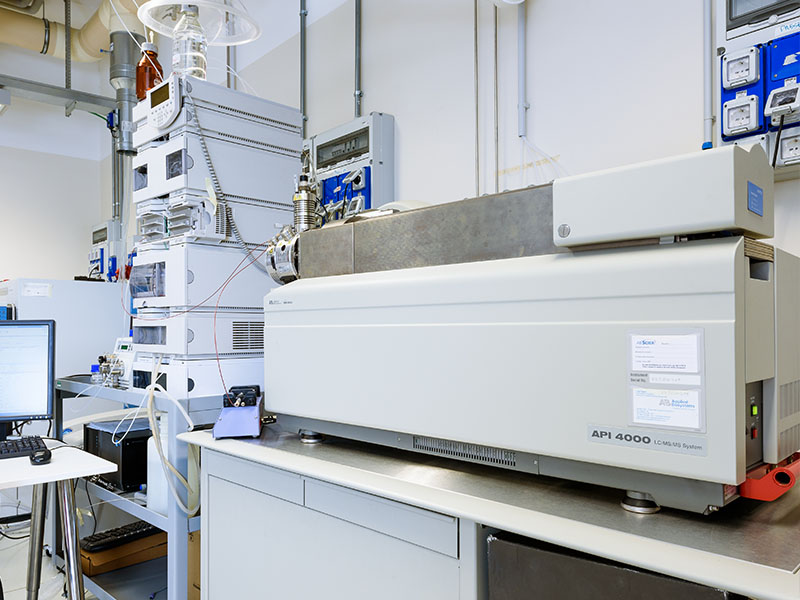
Ultra performance liquid chromatograph - high resolution mass spectrometer (UPLC-HRMS)
The instrument consists of an ultra-high performance liquid chromatograph (UPLC) Ultimate 3000 (Thermo Scientific) equipped with a nano pump and autosampler for high throughput, coupled to an LTQ Orbitrap XL mass spectrometer (Thermo Scientific). The ionization is obtained using a Nanospray Flex ion source (Thermo Scientific) equipped with a Picotip silica emitter. The MS/MS acquisition is downstream to a collision induced dissociation (CID) fragmentation and provides accurate mass measurement (<10 ppm) with high mass resolution (600,000) and sensitivity (low femtomole to high attomole). This instrument can carry out quantitative proteomics and metabolomics analyses over a wide dynamic range, including low-abundance peptides, and untargeted analysis of environmental and clinical samples with accurate identification of unexpected compounds.
Applications: proteomics, PTM characterization, metabolomics, untargeted analysis of compounds in complex liquid media.
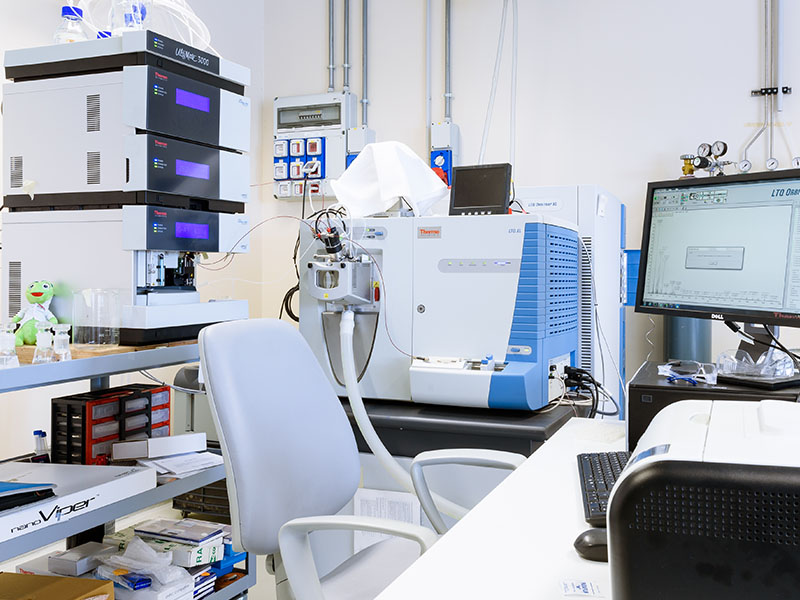
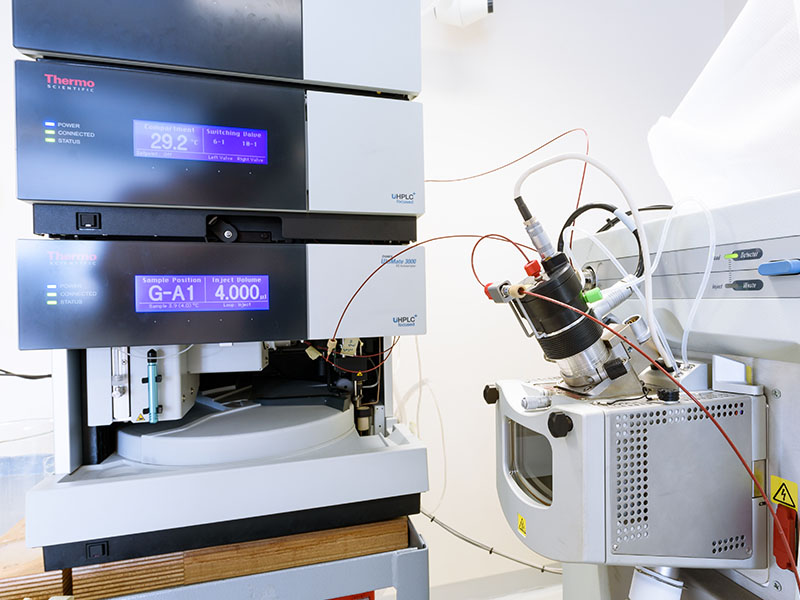
Gas chromatograph - tandem mass spectrometer (GC-MS/MS)
The instrument consists of a GC Trace 1310 (Thermo Scientific) equipped with user-exchangeable instant connect injector and detector modules, coupled to a TSQ 9000 triple quadrupole MS/MS detection system. The ExtractraBrite ion source is fully removable without breaking the vacuum probe interlock (VPI) to achieve fast operationality and switching from electron ionization (EI) to chemical ionization (CI). For the highest level of sensitivity the Advanced Electron Ionization (AEI) source can be configured to reach instrument detection limits into the attogram range. The instrument is suited for quantitative targeted and untargeted analysis of volatile/semi-volatile compounds.
Applications: SPE samples, pesticides residuals, persistent organic pollutants in food and beverages, waters, clinical samples, forensic sciences.
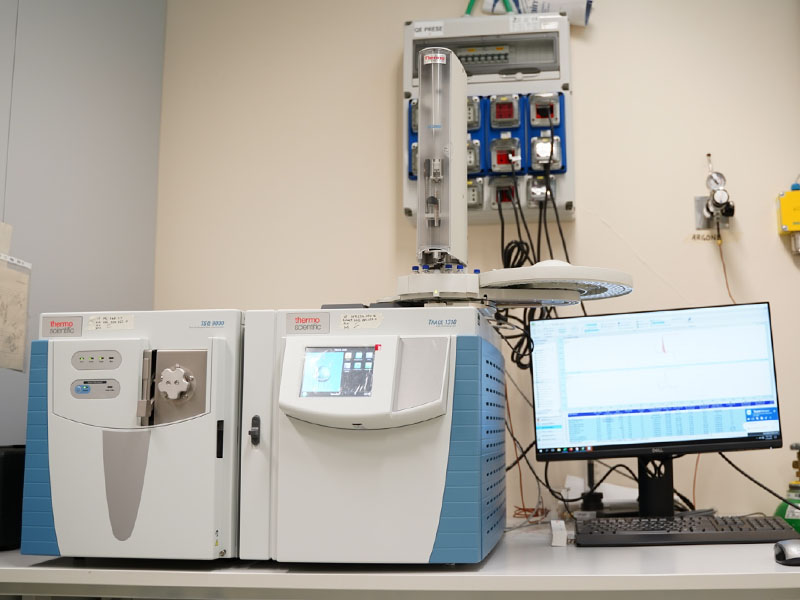
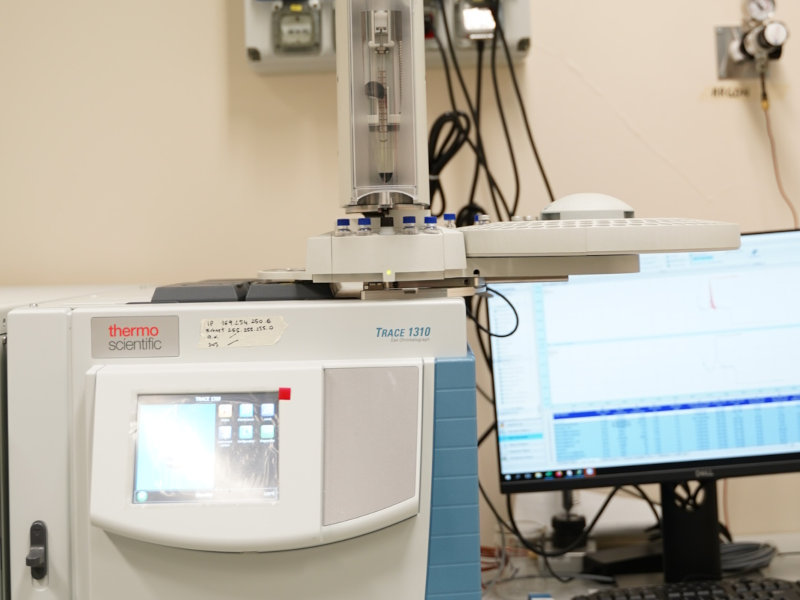
Gas chromatograph – mass spectrometers (GC-MS)
Three GC-MS analyzers are available at the Centre.
A single quadrupole 7890A-5975C GC-MS instrument (Agilent Technologies), equipped with an autosampler (G4513A, Agilent Technologies) and electron ionization source operated in positive mode. The instrument allows qualitative screening and quantitative determination of pesticides, lipids, persistent organic pollutants in environmental and biological matrices (aerosol, water, soil, sediment, biota).
A single quadrupole 7890A-5975C Cryo-GC-MS instrument (Agilent Technologies), equipped with a Unity2 (Markes International) thermal desorption system. The instrument is suited for the analysis of volatile and semi-volatile organic compounds (VOCs and SVOCs) in environmental matrices (indoor and outdoor air quality), food, forensics, consumer and other application fields (flavors and fragrances).
A PyGC-MS instrument 6890-5973N (Agilent Technologies), equipped with a pyrolyzer (CDS 5150). The instrument is suited for qualitative analysis of volatile (persistent organic pollutants, pesticides, etc.) and involatile compounds (paints, adhesives, plastics, synthetic fibers), in environmental, clinical, and forensic samples.
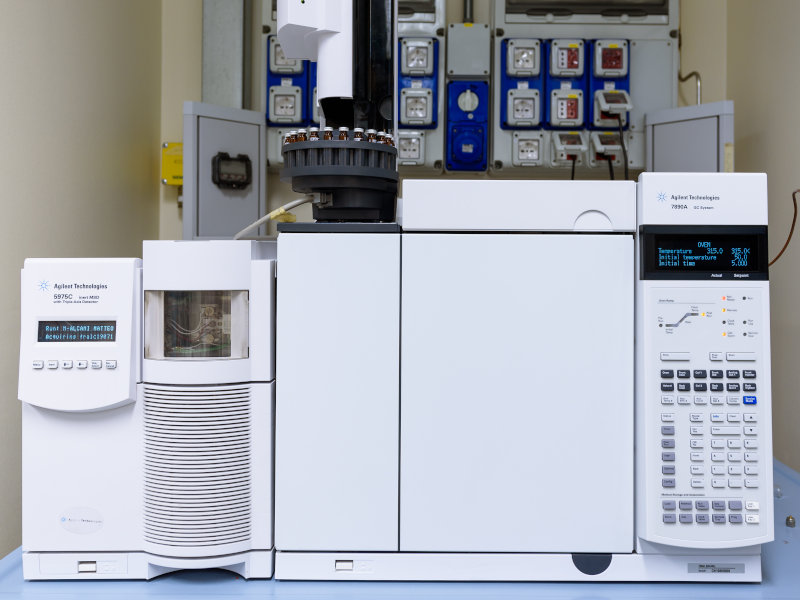
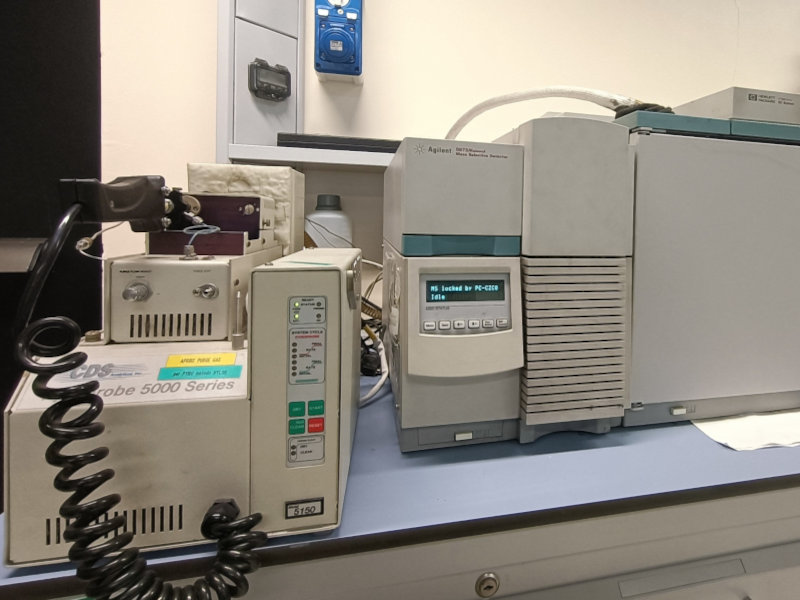
Transmission electron microscope with scanning mode (S/TEM)
The instrument JEOL JEM-F200 is a 200 kV TEM with scanning capabilities (S/TEM) equipped with a range of imaging detectors including: bright-field (BF); high-angle annular dark-field (HAADF); secondary electrons (SE); back-scattered electrons (BSE). The electron source is a Cold Filed Emission Gun (CFEG) which provides:
an electron beam energy spread ≤ 0.3 eV (FWHM) @ 200 kV;
- a brightness ≥ 8e8 A/cm2sr @ spot size = 0.7 nm;
- a probe current ≥ 2.5 nA @ spot size = 0.7 nm, in conjunction with the 4-lense illumination system.
The point resolution is ≤0.23 nm in conventional TEM mode and ≤0.16 nm in STEM mode, using the HAADF detector, with still the capability to tilt the sample up to angles ≥ 80°, which will allow the implementation of tomographic techniques in future.
The microscope is equipped with an energy dispersive X-ray spectrometry (EDS) detector with analytical resolution ≤ 133 eV @ 5.6 keV. The 100 mm2 active area assures a collection angle ≥ 1 sr, which, also given the probe current values, allows fast acquisition of EDS spectra and X maps even at the high spatial resolution corresponding to small probe sizes. This instrument enables extended experiments for a wide variety of applications allowing morphological, structural, and chemical nanoscale investigations.
Applications: analysis of composition, morphology and size distributions in vacuum and VP mode; ceramics; metals; glass; aerosol particles; chemical (elemental) imaging.
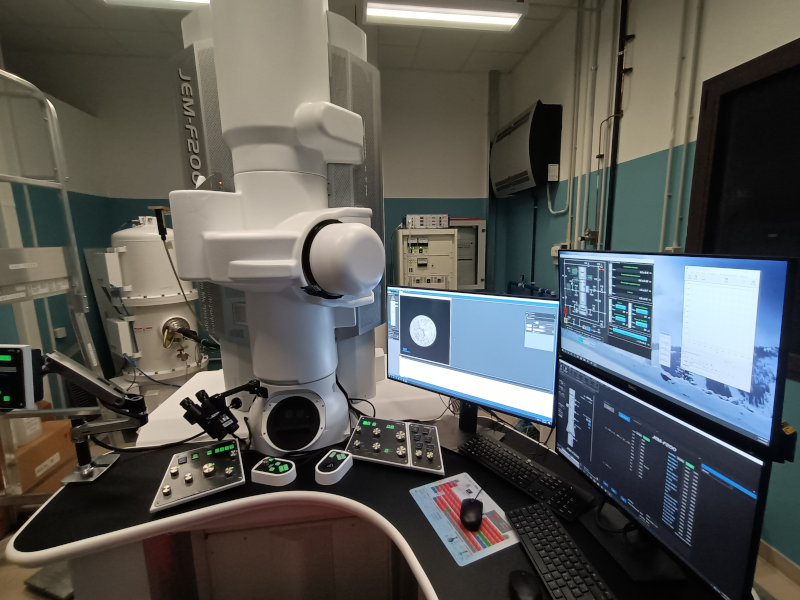
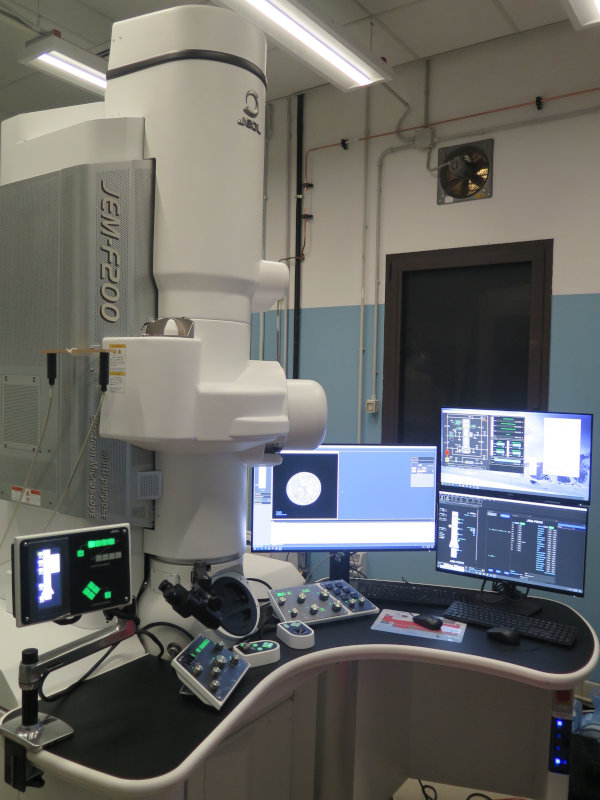
Scanning electron microscope (SEM)
The field emission (FE) SEM Zeiss Ʃigma|VP is equipped with a thermal field emission gun (Schottky emitter) source. The electron-optical column is a GEMINI design, and the instrument can work in variable-pressure (VP) mode, with pressures adjustable from 1 to 133 Pa, avoiding the need to coat non-conductive samples. The instrument is provided with a range of imaging detectors:
- conventional Everhart-Thornley detector for secondary electrons (SE), with high collection efficiency;
- 4-sector semiconductor detector for back-scattered electrons (BSE);
- high-resolution in lens detector for SE, which (together with the electron source and the column design) allows a nominal resolution down to 1.5 nm @ 15 kV.
The machine is also equipped with a Bruker Quantax 200, an energy dispersive X-ray spectrometry (EDS) system of the SDD type, with a 30 mm2 window which allows fast spectra and X maps acquisition; analytical resolution ≤127 eV @ 5.6 keV.
Applications: analysis of composition, morphology and size distributions in vacuum and VP mode; ceramics; metals; glass; aerosol, mineral and biological particles; chemical (elemental) imaging.
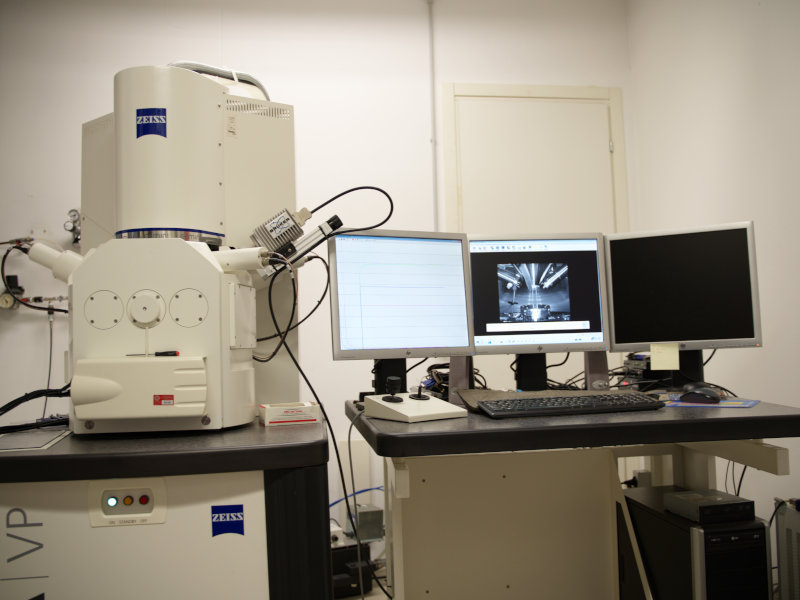
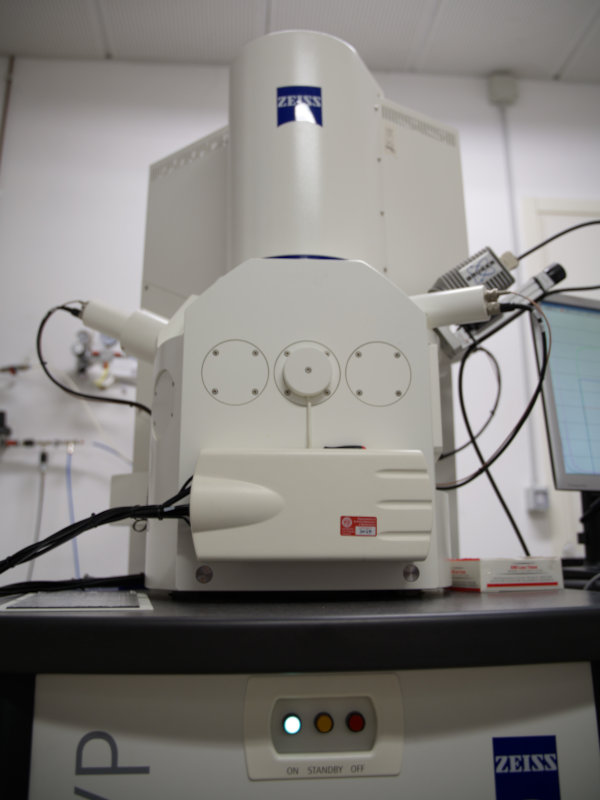
Atomic force microscope (AFM)
Dimension Icon (Bruker) is a tip-scanning AFM platform allowing nanoscale imaging. The analysis can be conducted in ambient and liquid environments. Depending on the requirements, three main modes with suitable probes are available: (i) contact mode, (ii) tapping mode and (iii) non-contact mode. In addition to the morphology of the samples, a wide variety of properties can be investigated. Nano-electrical properties of the materials with a spatial resolution of the order of 10 nm or less (depending on the AFM probe) can be investigated by means of conductive AFM (c-AFM) and Kelvin probe force microscopy (KPFM). The c-AFM allows to obtain topography and electrical conductivity maps of the samples by using a conductive tip. Nanomechanical analysis is also available (PeakForce-QNM®) by means of PeakForce Tapping® technology.
Applications: molecular engineering, surface chemistry, semiconductors and polymeric material science and cellular biology.
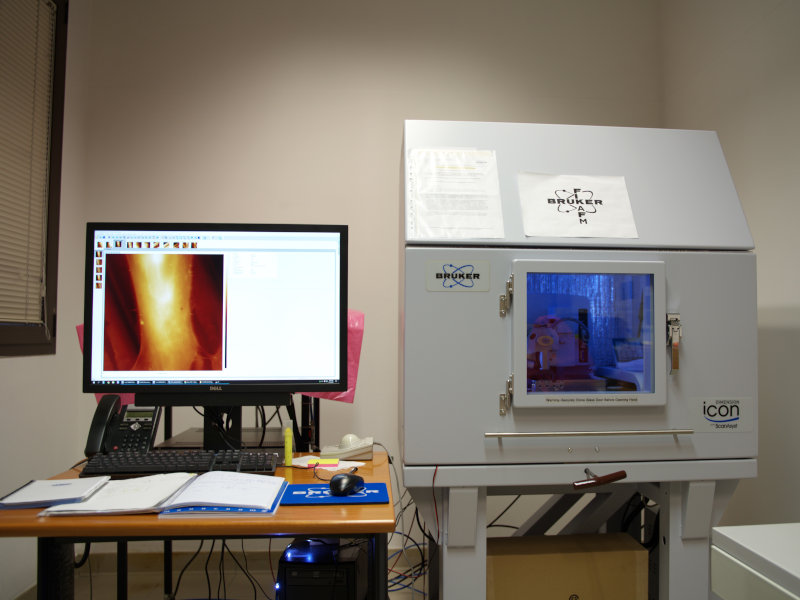
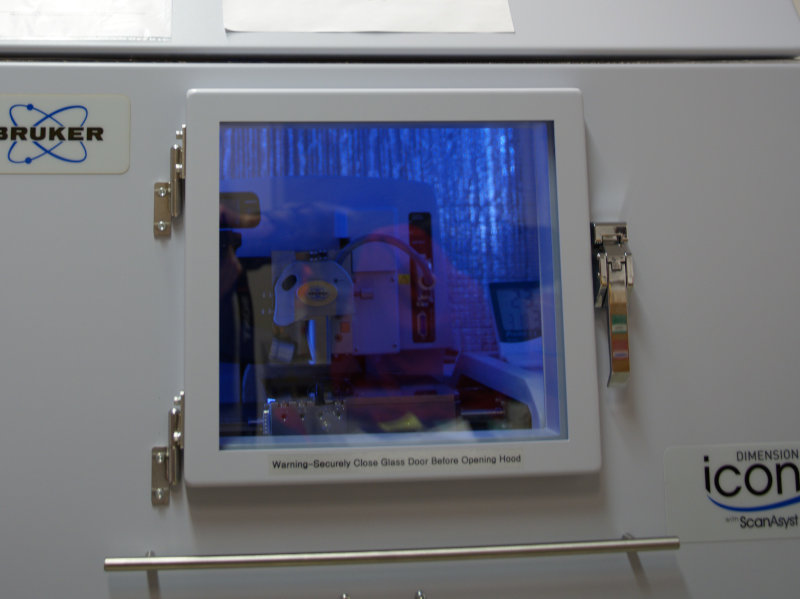
X-ray diffraction spectrometer (XRD)
The Empyrean Series 3 (Malvern Panalytical) is an X-ray platform for the structural analysis of powders, thin films, nanomaterials and solid materials in a single instrument. Standard wide angle X-ray scattering (WAXS) and ultra-small angle X-ray scattering (USAXS) modes are available for analysis in air and in liquid. The instrument is equipped with a point-like X-ray source, allowing to map samples with a spatial resolution of about 300 μm. In addition, grazing-incidence GISAXS and GIWAXS geometries are also implemented for the analysis of films and nanostructures deposited/grown on different substrates.
Applications: characterization of crystalline materials, identification of fine-grained minerals, sample purity, textural measurements, thin films characterization.
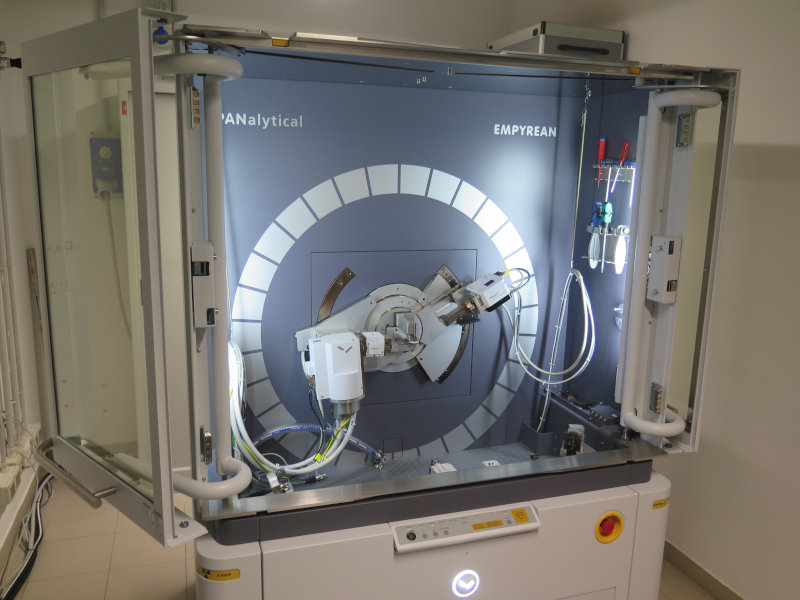
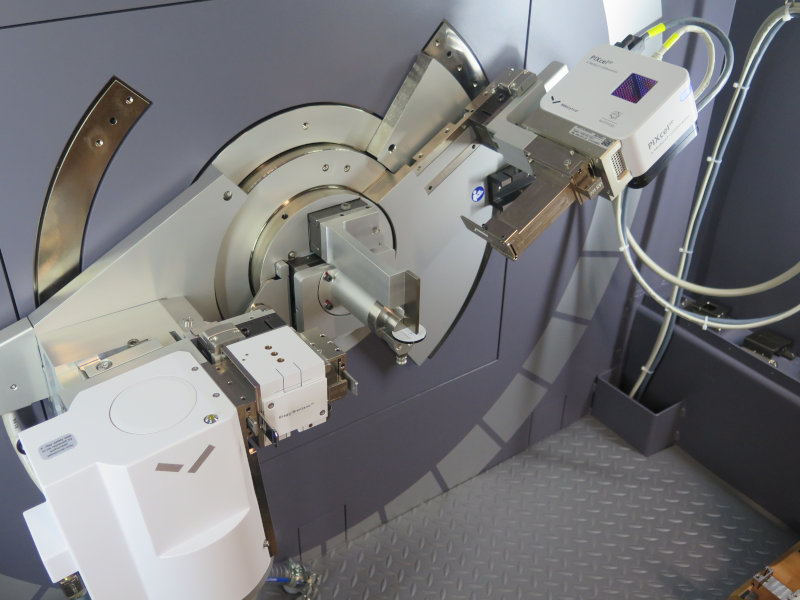
Col Margherita Atmospheric Observatory
The high-altitude observatory of Col Margherita (MRG) is currently the only station in the Eastern Alps providing measurements of atmospheric pollutants and the main meteorological parameters. The station is located on the top of Col Margherita at 2543 m a.s.l. (46.36 ° N - 11.79 ° E) in the municipality of Falcade (Belluno), near the border between Veneto and Trentino Alto Adige, in the mountain scenery of the Belluno Dolomites (UNESCO World Heritage Site since 2009). The Col Margherita observatory is part of the GAW-WMO stations network as a "GAW Regional station" since December 2019.
The MRG station is equipped with the following technical systems and scientific instrumentation:
- in-cabin electrical system equipped with automatic reset magnetothermal switch;
- rack for in-column analyzers positioning;
- atmospheric mercury analyzer (Tekran 2537B);
- bulk deposimeter for mercury in atmospheric depositions (Bus100, Eigenbrodt);
- weather station (plate naturally-aspirated solar radiation shield 41003-5|10 - Campbell Scientific; TRH sensor CS215 - Campbell Scientific; sonic ranging sensor SR50A - Campbell Scientific; in-cabinet T sensor model 109 - Campbell Scientific; PTB110 barometer – Vaisala; wind monitor-hd alpine model 05108-45 - Young; infrared radiometer model SI-111 - Apogee instrument)
- TECORA Skypost sequential low volume atmospheric aerosol sampler;
- internal/external webcam;
- local hard disk data backup system;
- data transmission system via GSM on remote call;
- on-line data visualization system on a terminal located in the cableway arrival station.
- low-cost sensor for tropospheric ozone (OX-B431);
- low-cost sensor for nitrogen dioxide (NO2-B43F).
Applications: air quality monitoring, meteorological monitoring, atmospheric pollutants, atmospheric aerosols.
